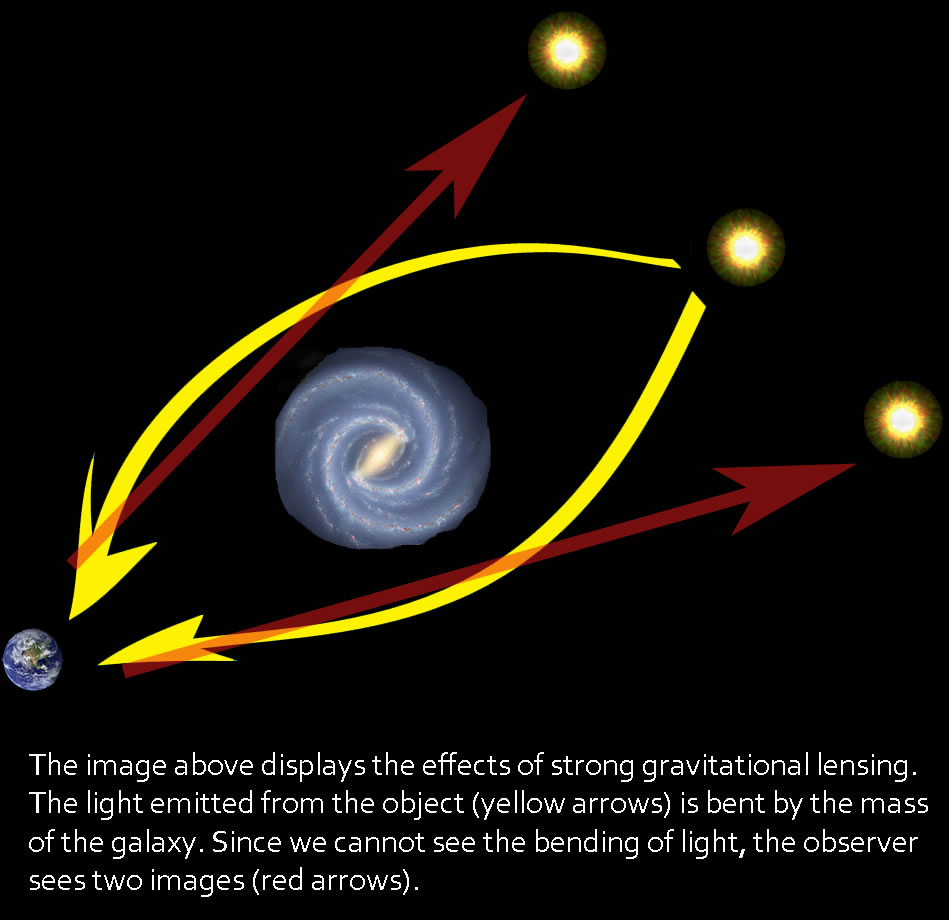
What Is Gravitational Lensing?
Gravitational lensing is basically a way for scientists to view distant galaxies. According to Einstein’s theory of relativity, gravity should bend light. Because of this, the light coming from distant galaxies should be bent around any source of gravity that is closer to the earth. For example, if we were looking at a somewhat near galaxy, galaxy A, with a more distant galaxy behind it, galaxy B, galaxy B’s light would bend around galaxy A and produce an image of itself around galaxy A. There are two types of gravitational lensing, strong vs. weak, but weak is readily more common today.
 \
\
Types of Gravitational Lensing Images
 The Einstein cross- It’s like the astronomical version of a four leaf clover. There’s little of the middle image but four groups of light spaced around the center. What seem to be four objects is actually just one distant object imaged into four.
The Einstein cross- It’s like the astronomical version of a four leaf clover. There’s little of the middle image but four groups of light spaced around the center. What seem to be four objects is actually just one distant object imaged into four.
 Multiple images often occur with weak lensing. This means that there are so many objects in the gravitational area that the distant galaxy gets bent into many images.
Multiple images often occur with weak lensing. This means that there are so many objects in the gravitational area that the distant galaxy gets bent into many images.
 Einstein rings are a very rare occurrence, but we are getting closer and closer every day. This only happens when the distant galaxy is directly behind the gravitational mass that bends its light. Other partial rings, or arcs, can be made when the positions of the masses aren’t directly in line with each other. You can see the different images that can be produced through this gravitational lens simulator.
Einstein rings are a very rare occurrence, but we are getting closer and closer every day. This only happens when the distant galaxy is directly behind the gravitational mass that bends its light. Other partial rings, or arcs, can be made when the positions of the masses aren’t directly in line with each other. You can see the different images that can be produced through this gravitational lens simulator.
 Lensing by a black hole-this animation shows a simulation of gravitational lensing caused by a Schwarzchild black hole passing in front of a galaxy in the background. The produced image can be seen within the black hole's Einstein Ring showing a bent mirror image of the galaxy. The brightness of the individual objects remains constant, but their angular size varies, producing an extremely bright image in the sky to the distant observer. The maximum brightness occurs when the galaxy is directly behind the black hole. The entire processs typically takes thousands, if not hundreds of thousands of years. Credit Wikimedia Commons under GNU Free Documentation License
Lensing by a black hole-this animation shows a simulation of gravitational lensing caused by a Schwarzchild black hole passing in front of a galaxy in the background. The produced image can be seen within the black hole's Einstein Ring showing a bent mirror image of the galaxy. The brightness of the individual objects remains constant, but their angular size varies, producing an extremely bright image in the sky to the distant observer. The maximum brightness occurs when the galaxy is directly behind the black hole. The entire processs typically takes thousands, if not hundreds of thousands of years. Credit Wikimedia Commons under GNU Free Documentation License